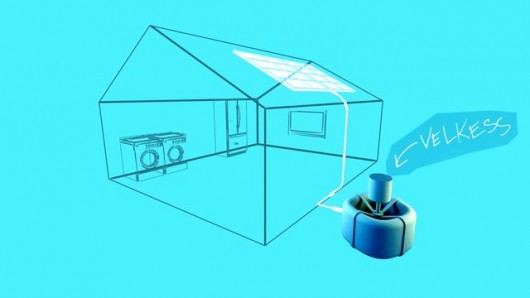Velkess flywheel technology promises cleaner, more efficient energy storage
April 16, 2013

Bill Gray is looking to the past to reinvent the future of energy storage with a new take on the spinning flywheel
It's no secret that the successful future of wind, solar and other renewable sources hinges on the development of cost effective energy storage systems.
Of the technologies currently in play, batteries are still expensive and limited in capacity, compressed air energy storage requires very specific spatial geological formations, thermal storage – often used in concentrated solar power (CSP) facilities – is also expensive and difficult to scale, and pumped storage hydroelectricity, while relatively inexpensive and efficient (70–85 percent), also requires specific geographical locations.
New approaches such as the ability to store energy in molecular bonds are also in development, but entrepreneur and inventor Bill Gray is looking to the past to reinvent the future of energy storage with a new take on the spinning flywheel.
Perhaps the most straightforward storage method of them all, energy storage flywheels have been in use for over a century. A flywheel is usually a heavy shaft-mounted rotating disc that absorbs and stores twisting or spinning motion and then releases it as rotational kinetic energy.
Armed with the pioneering research of John Vance, a retired professor at Texas A&M University (TAMU), Gray has developed a novel approach to flywheel design with a patent pending flywheel system called Velkess – short for VEry Large Kinetic Energy Storage System. According to Gray, Velkess is a radical improvement on existing flywheel technologies and is dramatically less expensive than even the most economical energy storage technologies available today.
Most existing flywheels are designed and built like the turbines of high performance jet engines. They use materials like carbon fiber composites and precision engineering to exactly control the forces inherent in all spinning rotors. These materials and the required engineering and control methods are extremely costly and not conducive to a low cost energy storage solution.
Gray’s “soft” rotor on the other hand is made of E-glass, operates in a vacuum and flexes in response to destabilizing forces therefore reducing the amount of stored power lost to friction down to about 2 percent on a daily basis. E-Glass or electrical grade glass (used in the reinforcing phase of fiberglass) is not as strong as carbon fiber but can store up to 20 times more energy per dollar. Like a cowboy’s lasso, it gains stability as it rotates and according to the company, the energy on the rotor can be held in complete safety even in the event of power failure or natural disasters like earthquakes.
The existing prototype flywheel floats on a high efficiency magnetic bearing assembly, can make or absorb 2 kW of power, and can store 0.5 kWh of energy. Gray needs to scale that storage capacity up 30 times to 15 kWh. That requires replacing the 25 lb flywheel rotor seen in the video with a 750 lb version.
“Our challenge is with the magnetic assembly," says Gray. "The magnets to float 25 lbs are easy to get on the internet and easy to work with by hand. Magnets strong enough to float 750 lbs, are a different story. They need to be custom made and are too powerful to safely work by hand.”
Gray has successfully raised funds on Kickstarter for the next phase of development which will fund the construction of a magnetic bearing and motor assembly. This is the final piece of the puzzle for the completion of a fully working prototype which would pave the way for demo units which will be used to market the invention to potential buyers.
More technical information about the Velkess flexible flywheel can be found in the Patent Application.
Sources: Velkess, Kickstarter
